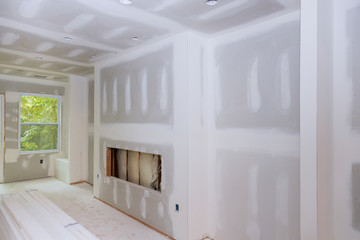Drywall Repair Las Vegas is one of the most satisfying home improvement projects for do-it-yourselfers. There are a few things to consider though.
Pro Tip: For drywall repairs that involve nail holes, use a self-adhering mesh patch to cover the hole and prevent shifting. Fill the patch with a layer of joint compound, then smooth and sand the repaired area to blend.
Fine cracks that extend only across the surface of a wall are often the result of the natural settling of your home or from drywall joints and seams that weren’t properly reinforced with drywall mud and tape. They’re not a sign that your house is about to fall down and they’re usually easy for a DIYer to repair.
If the cracks are long and wide, however, they may mean that there’s a structural issue. It’s best to bring in a professional for this type of major crack, as it will likely require a longer repair process, including re-enforcing the entire wall.
To fix the cracks, first widen them with a paint scraper or utility knife to reveal any loose plaster and debris inside the crack. If there’s no additional damage, then you can simply fill the crack with new drywall compound.
If you want to be extra thorough, use a self-adhering mesh tape to reinforce the seam or joint, as shown in Image 2. Then apply a few skim coats of drywall mud, letting each one dry before applying the next. This will ensure that you have a solid base for your final patch and paint job.
You can also choose to fill the cracks with a simple caulking, which will work in a pinch. But if you’re planning to do this, make sure you use a caulking that is designed for exterior use. Otherwise the caulk will fail, leading to leaks and possible mold problems down the road.
When a crack appears on the corner of your drywall, it’s generally caused by stress at the joint, which can pull the drywall away from the metal edge bead that holds it to the stud. To fix the problem, start by using a drywall knife to widen the crack so you can more easily apply new compound.
Then apply a strip of paper drywall tape to the crack, fold it lengthwise along its center crease and press it into the wet compound. Then use a six-inch putty knife to smooth the tape, squeezing out any excess compound and air. After the first side of the tape has dried, apply a second and third coat of compound, extending it 6 to 7 inches on both sides of the crack. Let each coat dry before sanding the surface smooth and painting.
Patching Holes
Small holes caused by nails, hooks, screws and other fasteners that are used in drywall are easy to fix. You can use a little non-shrinking spackling compound to fill in the hole, let it dry and then repaint the area. But larger holes need something more substantial to keep them from collapsing into the wall.
To patch large holes, cut a square of new drywall that is about twice the size of the hole in your wall. Using your stud finder, locate the studs on either side of the damaged section and mark them. Use your utility knife to cut along the marked lines. Then, remove the old piece of drywall from the wall.
Next, sand the edges of the hole and the surrounding wall until it is smooth and even with the rest of the wall. Wipe off the sanding dust with a damp cloth. Finally, if you are repairing a particularly large hole, you may need to add some bridging material to the surface of your new patch. We used a piece of adhesive-backed fiberglass mesh that came in our patch kit (less than $2). Cut a piece to overlap the hole by at least 1 in. on all sides, peel off the paper backing and press in place.
Now, to prepare the patch for mud, wet the paper edges of the new drywall patch and stick it in place. With your drywall knife, apply a thin layer of spackling compound over the patch. When it dries, sand the surface lightly with your sanding sponge and apply a second thin coat of spackling.
For the final step, screw the patch into the wall. Make sure the screws go into both the support boards and the studs in order to hold it securely.
Once the mud has dried, sand again with your sanding sponge until it is smooth and even with the rest. Wipe away all sanding dust and then paint the patched area with a matching color of drywall primer/paint. If you have a lot of holes to fix, it will be faster and easier if you prime all of the patches at once before you begin the actual painting.
Re-Painting
The interiors of many homes and commercial buildings are covered with gypsum wallboard, also known as drywall. While drywall is durable, it is not indestructible, and over time, dents, cracks, and holes can develop. While a fresh coat of paint will hide most drywall imperfections, it is important that the damaged surface be repaired before painting to ensure that the new coating lasts.
While some drywall repair is best left to professionals, minor, isolated holes and dents in drywall are relatively easy do-it-yourself projects. Using pre-mixed or mix-your-own drywall compound, filling the holes and dents, and lightly sanding the area can be done with minimal effort. However, before you get started, it is important to be sure that you have the appropriate tools and skills to complete the job.
Even though drywall is durable, it can be dented by anything from falling televisions to roughhousing children. These dents can be repaired with a patch kit designed for such occasions, which are usually fairly simple to use. The trick is to make sure that the underlying drywall surface is not damaged when removing the nail or screw, and to use the right type of drywall putty.
It is also important to note that drywall patches may have different textures than the surrounding drywall. This can be a problem when painting over the patch, as the difference in texture can show through the paint. To avoid this, it is a good idea to apply a light coat of primer over the patch before applying a topcoat of paint.
For more serious drywall damage, it is always a good idea to call in a professional. Not only can they help with repairing the cracks and dents, but they can also inspect your drywall for structural problems that could require further repairs. Taking care of these issues now will help to keep your home safe and sound for years to come.
When choosing a drywall contractor, it is important to check for references and reviews. Many consumer websites such as Angie’s List and HomeAdvisor have user-submitted reviews and ratings of drywall contractors. You should also look for a contractor with a license and insurance. In addition, it is a good idea to ask the contractor about their experience and track record with other clients.
Repairing Water Damage
Water damage is a big problem that can lead to mold, rot and other structural issues in your home. It can be caused by natural events like flooding or hurricanes, as well as a burst pipe, sink overflow, condensation from your air conditioner and more. If left untreated, it can cause expensive and extensive structural damage. It is important to address and repair the issue as soon as possible to prevent further damage.
Before beginning drywall repairs, it is necessary to ensure that the wall is dry and any standing water has been removed. This is especially important if the drywall has been exposed to water for a long time. The longer the drywall stays wet, the more likely it is to warp or buckle. It is also important to make sure that the source of the water has been addressed and eliminated.
If you have been experiencing water problems in your home, it is important to contact a professional drywall contractor immediately to assess the extent of the damage and to perform the proper drywall repairs. They will be able to fix the damaged areas, clean the affected walls and ceilings, and then apply a sealer to the surface to protect it against further damage.
When performing drywall repairs on water damaged areas, it is crucial to use a primer before applying the drywall mud. This will help to prevent the mud from adhering to the drywall and making it difficult to work with. It is also important to allow the drywall to completely dry before proceeding to paint.
Once the drywall has dried, it is important to inspect it for any additional damage. If there are any dents or holes, they should be filled with a joint compound. Make sure to let the compound dry thoroughly before sanding it down and priming again.
Drywall repair is a common and necessary process that every homeowner will have to do at some point. While it may seem like a daunting task for the average do-it-yourselfer, with some patience and care, it can be done relatively easily. By taking a few simple steps, you can have your drywall looking as good as new again in no time.





